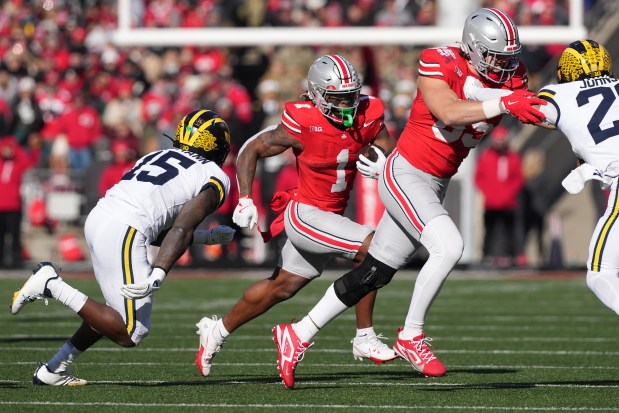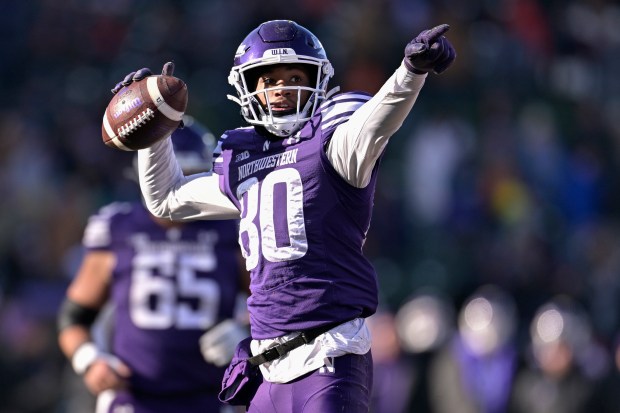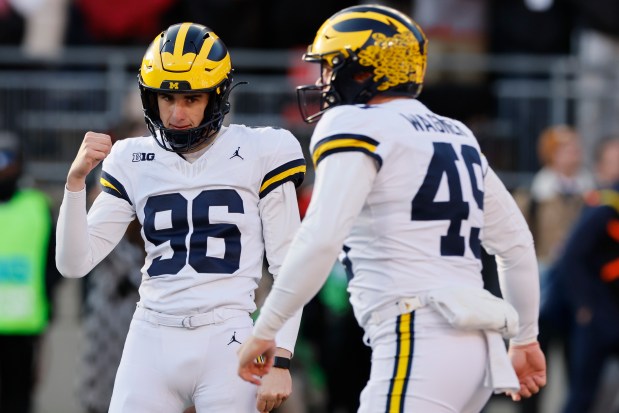The Big Ten expanded from 14 to 18 teams this year, watched Curt Cignetti revive an Indiana program that’s been underground for more than half a century, and arguably established itself as the nation’s dominant college football conference with three of the top four-ranked College Football Playoff teams entering the final weekend of the regular season.
Everything was falling into place before Saturday’s regular season-ending shocker — Michigan’s 13-10 win over No. 2 Ohio State in Columbus, Ohio — followed by the viral video of the teams brawling in the middle of the field after Wolverines players attempted to plant their flag.
The Ohio State loss opened the door to the conference title game to No. 4 Penn State, which beat Maryland 44-7 on Saturday.
For too many years to mention, it’s been Ohio State, Michigan or punt for the Big Ten title. And since both played in the same division, “The Game” typically served as the de facto conference championship game. This year’s matchup was supposed to be devoid of drama, a punctuation mark on the Buckeyes’ regular season as it prepared for next week’s title game in Indianapolis, and the CFP beyond.
But Saturday’s epic reboot, after Michigan entered the Horseshoe as 23 1/2 point underdogs, was further evidence nothing else matters in the Big Ten when the Buckeyes and Wolverines kick off.
Northwestern and No. 23 Illinois attempted to disprove this theory with an 11 a.m. kickoff at the friendly, frozen tundra of Wrigley Field, where the Illini won 38-28 to capture the Hat and leave the Wildcats 0-5 in their years hosting games on the city’s North Side.
No matter how it all ended, the first Big Ten football season with 18 teams showed that bigger really is better, under the right circumstances. With conference realignment, dissolution and overall madness in college football, the real battle this year was between the Big Ten and SEC, the Power Two.
The great college football debate soon will be answered with the first 12-team playoff, after next weekend’s conference title games.
There was no disputing the SEC had higher TV ratings and more ranked teams. And to its legion of fans, the SEC experience is a way of life, a Saturday ritual led by ESPN’s Southern football evangelist, Paul Finebaum.
But is it really superior to the Big Ten?
No. 7 Georgia’s eight-overtime win over unranked Georgia Tech on Friday seemingly destroyed the myth that an unproven Big Ten team like No. 10 Indiana couldn’t survive against the top SEC programs. Then a 6-5 Michigan team stopped Ohio State, as SEC purists nodded their heads.
Image is everything, and even with the addition of the Pac-12’s Big Four, the Big Ten can’t replicate the pride SEC fans feel toward their conference. I’m not sure anyone in the Midwest is excited about Dillon Gabriel and the No. 1 Oregon Ducks repping the Big Ten in the Rose Bowl. It’s still a parochial conference, mostly filled with schools that have spent the last several decades trying to finish third behind Ohio State and Michigan.

Oregon and Indiana made this season a lot more fun, as difficult as it was to accept the Ducks as a Big Ten team or Indiana as anything other than a basketball school.
“I’m not into labels (like) ‘They’re a top-15 team,’” Cignetti said after the Hoosiers’ opening conference win at UCLA. “At the end of the year, we’ll see what our resume looks like. But there is no one in our locker room (that’s) surprised.”
There’s no reason why Illinois couldn’t be in the same boat as Indiana, which played Purdue on Saturday night with a top-10 ranking and probable playoff invite in the offing. This 9-3 season is Illinois’ best since the 2007 Rose Bowl year, capped by Saturday’s win at Wrigley, where Aidan Laughery rushed for 172 yards and three touchdowns.
College football at the Cubs’ ballpark was a much harder sell Saturday than the last game on Nov. 16, when the ivy was still clinging to the bleacher walls, Ohio State fans staged a friendly takeover of the ballpark, and the Buckeyes cruised past the Wildcats on a spectacular fall afternoon before a festive crowd of 38,147.
Three out of four Wrigleyville bartenders polled would rather have the Cubs simply invite Ohio State to play annually at Wrigley. Bringing High Street to Clark Street was a godsend for some establishments just getting by in the winter months.
Northwestern and their gracious landlords, the Ricketts family, rolled the dice by scheduling a post-Thanksgiving game at Wrigley, the first time the Cubs hosted two NU football games in the same season. Illini fans made up the bulk of the announced crowd of 26,378, but the atmosphere was markedly muted compared to the OSU-Northwestern game, thanks to a late-arriving crowd due to the cold weather. There was sparse outdoor pre-partying at Murphy’s, Gallagher Way and other places, which affected the early buzz.

One concession stand at Wrigley sold spiked hot cocoa with a shot of bourbon cream, schnapps or Maker’s Mark for $18.99 a cup, plus tax, proving you can take the Cubs out of Wrigley Field, but you can’t stop Crane Kenney’s wheelbarrow of progress.
The NU-Cubs bromance is one of Kenny’s longest-lasting partnerships and was supposed to lead to bigger things. Back in 2017, the Cubs president of business operations even told the Tribune a bowl game was in Wrigley’s future.
“Concerts that may not sell out elsewhere sell out at Wrigley,” Kenney said. “It’s because of the ballpark, Wrigleyville, Chicago, the history. It gives us confidence that a bowl game will succeed here.”
Maybe not. The swaths of empty seats Saturday suggested the idea of creating a low-tiered bowl game sponsored by an insurance company or car parts manufacturer in mid-to-late December at Wrigley was probably a non-starter.
Saturday’s game lacked the gravitas of the 2010 Illini-Wildcats matchup remembered fondly as the “One-Way Game” because the east end zone couldn’t be used for safety reasons. The crowd was comparable to a mid-April, afternoon getaway day game between the Cubs and Cincinnati Reds, baseball’s equivalent of a Citrus Bowl candidate versus a bowl-ineligible team.
Still, NU marketing honchos can consider their Wrigley venture in 2024 an unqualified success. Northwestern helped make its athletic department — and the Cubs — a lot more revenue by playing two games at the iconic ballpark instead of in their cozy, Instagram-ready, temporary, on-campus stadium by the lake.
The Cubs can thank Ohio State for helping make the games at Wrigley a big hit. But maybe they should wait a few days before calling.




